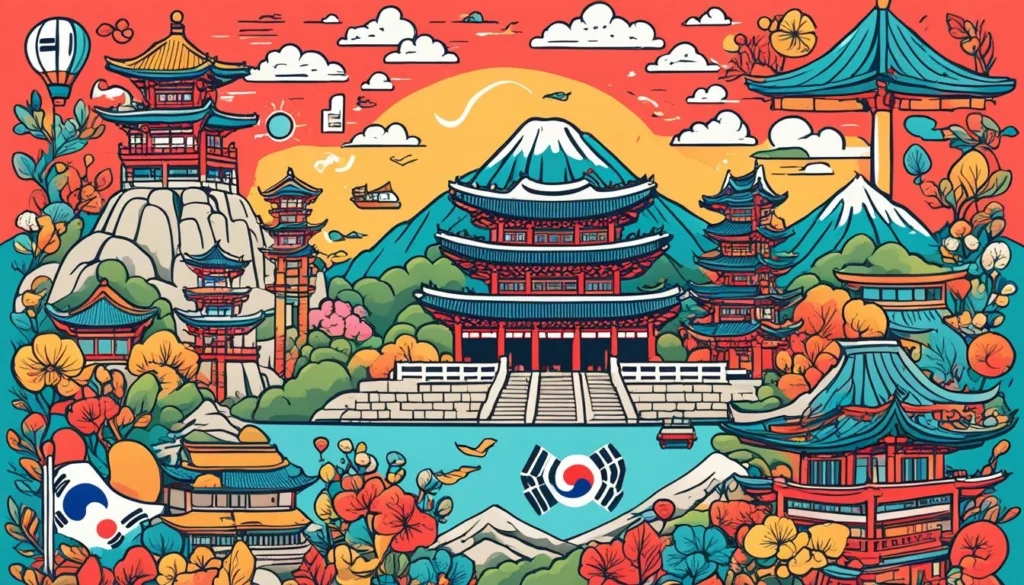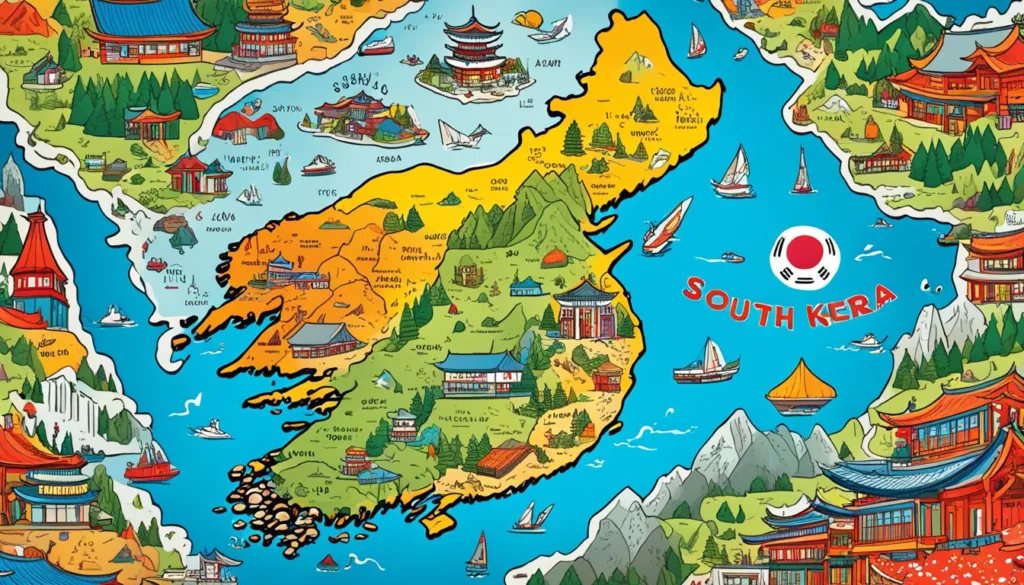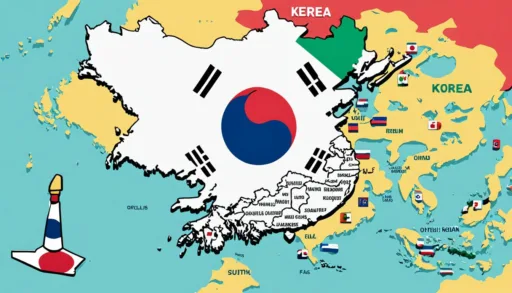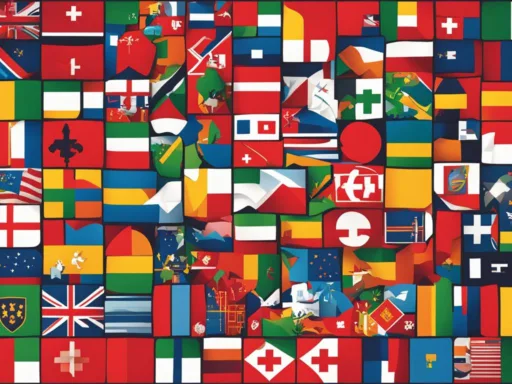Did you know that the Korean language, with its unique Hangul script, is spoken by a population of approximately 81.7 million people worldwide? South Korea, while known for its linguistic homogeneity, harbors a rich tapestry of South Korean dialects and language influences. Korean, the official language in South Korea, serves as more than just a medium of communication—it’s a gateway to understanding a nation’s identity and its intricate language diversity South Korea prides itself on.
Key Takeaways
- While Korean is the official language, South Korea’s linguistic landscape is enriched by distinct regional dialects.
- Korean dialects contribute to the peninsula’s cultural diversity, much like the various languages spoken in South Korea.
- The evolution of Korean, through stages of Old and Middle Korean to the modern standard, reflects the deep historical roots of the language.
- Hangul, Korea’s national script, is recognized for its unique design that differs remarkably from other language systems.
- Jeju language serves as an example of how regional variations can lead to significant linguistic divergence within a country.
- Language diversity in South Korea also extends to include foreign language influences and the Koreanic languages spoken by diasporic communities.
Introduction to the Linguistic Landscape of South Korea
Delving into the palette of languages across the Korean Peninsula reveals a consistent yet dynamic linguistic landscape. The common language that sews the fabric of South Korean society is undoubtedly Korean, but the peninsula’s speech varies from its standardized forms in Seoul to distinct dialects in remote areas. This linguistic diversity underlies the rich cultural heritage and complex sociopolitical history of the region. To appreciate the depth of South Korea’s linguistic identity, one must embark on a journey through its language evolution, dialectal variance, and historical context.
An Overview of the Korean Language
At the heart of linguistic communication in South Korea is the Korean language, known as hangugeo among South Koreans. A language vibrant with history and cultural significance, it stands alone in its script and structure from its neighboring tongues. Most notably, the invention of Hangul in the 15th century marked a revolution for Korean literacy and continues to be a source of national pride.
Language Diversity in the Korean Peninsula
The linguistic landscape of South Korea is not monolithic but punctuated by a range of dialects, each carrying its unique intonation, vocabulary, and grammatical traits. The prominence of the Gyeonggi dialect due to its use in Seoul has unwittingly set a standard, shaping the common language understood across South Korea. However, this standardization does not diminish the richness of regional dialects that contribute to the overall tapestry of the nation’s language.
The Historical Context of Language in South Korea
Tracing back the lineage of Korean, one encounters Old Korean and Middle Korean, precursors to the modern form. These historical stages, together with Hangul‘s establishment, which dramatically shifted writing practices away from Hanja, exemplify the evolutionary path that has led to contemporary Korean. This historical journey is reflective not only of linguistic changes but also of societal transformations within the peninsula.
| Language/Dialect | Region | Notable Features |
|---|---|---|
| Standard Korean (hangugeo) | Throughout South Korea | Seoul-influenced pronunciation |
| Gyeonggi Dialect | Gyeonggi Province | Standard language basis |
| Jeolla Dialect | Jeolla Province | Unique intonational patterns |
| Gyeongsang Dialect | Gyeongsang Province | Distinguished vocabulary and tones |
| Jeju Language | Jeju Island | Significantly divergent from standard Korean |
Unpacking Korean: The Foundation of Language in South Korea
Korean holds the esteemed position as the official language in South Korea, serving as a bridge throughout the Korean Peninsula and beyond. Its structure and history present a captivating tale of linguistic endurance and evolution. The development of Modern Korean from its prehistoric roots, through various reforms including the introduction of Hangul, unfolds a rich tapestry of linguistic progression. The language’s unique featural components set it apart, marking its distinctness within the world’s languages.

In the South Korean context, Korean is more than a means of communication—it is the lifeblood of the nation’s identity. This is reflected in how language diversity in South Korea is largely a diversity of dialects rather than distinct languages. The relationship between North and South Korean language standards, although subtly varied, reflects the shared linguistic foundation, while simultaneously highlighting the nuances that geography and politics can impress upon a language.
Hangul, the crown jewel of Korean linguistic identity, has had significant impact in shaping the Korean language as we know it today. Originated by the esteemed King Sejong, its design promotes literacy and preserves the linguistic integrity of Korean. The Hangul script, rich in featural alphabetic elements, typifies Korean and distinguishes it from other language families.
- The Seoul dialect, based on the Gyeonggi province vernacular, forms the standard language.
- Introduction of Hangul by King Sejong revolutionized Korean literacy and record-keeping.
- Cultural identity and communication amongst the 51 million South Koreans are deeply interwoven with the Korean language.
- The nuanced language diversity in South Korea echoes through various regional dialects, each bearing a story of its own.
Grasping the depth and breadth of Korean’s influence provides insight into a language that resonates with the hearts of millions and stands as a symbol of South Korea’s cultural pride.
Korean Dialects: A Tapestry of Regional Linguistic Variety
The cultural landscape of South Korea is intricately woven with threads of language diversity, shaped over time through its myriad of South Korean dialects. Each region contributes its own rich hues to the overall linguistic mosaic, inviting an exploration of the country’s regional linguistic variety.
The Gyeonggi Dialect: Standard Korean
As the principal dialect used in the country’s capital and surrounding areas, the Gyeonggi dialect has risen as the basis for standard South Korean. It boasts nuances that are recognized and understood nationwide and has been instrumental in educational and administrative communications.
Understanding Jeju Language: A Distinct Form of Korean
Veering from the standard linguistic norms, the Jeju language echoes the unique history and traditions of Jeju Province. Speaking volumes of the island’s independent identity, this language is preserved largely by the older generations, making it a precious but vulnerable part of the language diversity in South Korea.
Regional Dialects: From Gyeongsang to Jeolla
The Gyeongsang and Jeolla dialects resonate with distinctly pronounced tonalities, reflecting the geographical diversity and cultural depths of South Korea. These dialects serve as living museums, showcasing the heterogeneity and phonological variety that enrich the Korean linguistic landscape.
Below is an illustrative guide to some of the fascinating differences among the well-known regional dialects:
| Dialect | Region | Characteristics | Intelligibility with Standard Korean |
|---|---|---|---|
| Gyeonggi/Seoul | Seoul Metropolitan Area | Standard reference, neutral tones | High |
| Jeju | Jeju Province | Vastly different vocabulary and phonetics | Moderate to Low |
| Gyeongsang | Southeastern Region | Stronger intonation, pitch differences | Moderate |
| Jeolla | Southwestern Region | Unique melodic intonation, various expressions | Moderate |
The kaleidoscope of dialects across South Korea is far more than just a means of communication; it embodies the nuanced history and evolving identity of a nation committed to preserving its heritage while navigating the modern world.

Hangul: The Unique Script of the Korean Language
The splendor of Hangul script is not merely its visual elegance but its role as a tool of empowerment in Korean society. It emerged in the 15th century, at a time when the Korean peninsula was ensconced in the complexities of the Hanja system, which adopted classical Chinese characters. The inception of Hangul by the enlightened ruler Sejong the Great was not just the birth of a script but a societal transformation. It brought a comprehensive and accessible alphabet that allowed the masses to engage with the written word, enhancing literacy across social strata.
With foreign languages in South Korea, the mastery of Hangul remains a foundational stone in the preservation of national identity and cultural heritage. Its 24 basic letters, consonants, and vowels, alongside 27 complex characters, map directly onto the spoken sounds of Korean. This featural writing system is celebrated for reflecting the phonetic nature of the language distinctly.

While Hangul predominates in modern Korean communication, vestiges of Hanja still resonate within educational settings and academic texts, upholding an academic tradition deep-rooted in history. Hangul’s creation story and the simplicity of its design mirror the progressive strides that South Korea has made, becoming a beacon of innovation and education within Asia and globally.
| Component | Description |
|---|---|
| Basic Consonants | There are 14 basic consonants that mirror the shape the mouth makes when the sound is produced. |
| Basic Vowels | 10 basic vowels represent three elements: man (a vertical line), earth (a horizontal line), and heaven (a dot). |
| Complex Letters | These 27 letters are combinations of basic vowels and consonants to produce compound sounds. |
| Featural System | The design of each character is based on phonetic features that correspond to the articulatory properties they represent. |
As South Korea continues to captivate global attention with its cosmopolitan outlook and technological leaps, the Hangul script stands as a unique embodiment of the country’s spirit—a script not only facile in its learning but mighty in its unifying force among Koreans at home and abroad.
Languages Spoken in South Korea
In the heart of East Asia, South Korea presents a dynamic linguistic environment where tradition meets modernity. Steeped in a rich linguistic history, the country is primarily characterised by the Korean language, with its epicenter in Seoul influencing the linguistic tide across the nation. The Seoul-influenced Gyeonggi dialect is not just prevalent but sets the de facto standard for the Korean language throughout South Korea. This influential dialect provides a framework for media, education, and governance, encapsulating the essence of the languages spoken in South Korea.
The Gyeonggi Dialect: Seoul’s Linguistic Norm
The Gyeonggi dialect, emanating from the bustling capital of Seoul, has achieved prominence as the linguistic yardstick against which all other dialects are measured. It’s more than just a way of speaking; it’s regarded as the epitome of clarity and modernity in Korean speech. As Seoul continues to be the fulcrum of economic and cultural activities, its dialect naturally embeds itself into the daily lives of its citizens, cementing its role as the primary conduit of communication across various domains of South Korean society.
Language Use in Jeju: Dialect Versus Standard
Beyond the mainland, language use in Jeju showcases the island’s unique linguistic heritage. Resonating with the local culture and history, the Jeju dialect stands in stark contrast to standard Korean. While there is a profound appreciation for this dialect among linguistic scholars and older generations who strive to preserve it, the overwhelming influence of the Gyeonggi dialect prevails, often relegating the local tongue to the peripheries of mainstream usage.
Examining the Tonal Differences in Yeongnam’s Dialects
Language in South Korea is not monolithic, as evidenced by the tonal diversity found in Yeongnam’s dialects. These dialects, spoken in regions like Gyeongsang, adorn the linguistic landscape of the country with their unique intonations and vocabularies. As South Koreans continue to celebrate and explore their linguistic diversity, it’s these distinctions that underscore the intricate interplay between languages and cultures within the nation. Increasingly, efforts are being made to document and preserve such regional variations as they represent an irreplaceable facet of the nation’s cultural mosaic.
FAQ
What Languages are Spoken in South Korea?
The official language spoken in South Korea is Korean. However, various regional dialects exist throughout the country, including the Gyeonggi dialect spoken in Seoul, which is the standard form of Korean in South Korea. Other dialects include Jeju language, Gyeongsang, and Jeolla, among others. In addition to these Korean dialects, there is also a presence of foreign languages such as English, Chinese, and Japanese due to international relations and education policies.
What is the Linguistic Landscape of South Korea Like?
The linguistic landscape of South Korea is relatively homogeneous with Korean being the dominant language. Despite this homogeneity, there is a rich tapestry of regional dialects that add to the language diversity in South Korea. Each region contributes its unique linguistic traits, which are influenced by historical, geographical, and social factors.
Can you provide an Overview of the Korean Language?
Korean, known as ‘hangugeo’ in the South and ‘chosŏnmal’ in the North, is a language with deep historical roots dating back to Proto-Koreanic. It evolved through various stages including Old, Middle, and Modern Korean. Today, it is distinguished by its own unique alphabet called Hangul, developed in the 15th century. The language encompasses different dialects and reflects a complex system of speech levels and honorifics.
How does Language Diversity Manifest in the Korean Peninsula?
Language diversity in the Korean Peninsula is primarily represented through the different Korean dialects spoken across the regions. While there is a common linguistic thread, the dialects often present variations in vocabulary, pronunciation, intonation, and grammatical structures. Such diversity reflects the peninsula’s rich cultural and historical landscape.
What is the Historical Context of Language in South Korea?
The historical context of language in South Korea is deeply intertwined with the country’s cultural and societal developments. From the ancient Proto-Koreanic language to the adoption and creation of Hangul, the language has been influenced by political changes, cultural exchanges, and technological advancements, shaping the modern Korean language we know today.
Why is Korean Considered the Foundation of Language in South Korea?
Korean is considered the foundation of language in South Korea because it is the primary medium of communication, education, and cultural expression. It is central to Korean identity and is used uniformly in government, media, and all forms of daily interaction. The standardization of the Seoul-influenced Gyeonggi dialect has further solidified Korean’s role as the core of linguistic activity in the country.
What Role Does the Gyeonggi Dialect Play in South Korean Language?
The Gyeonggi dialect, being the dialect of Seoul and its surrounding areas, forms the basis for standard Korean in South Korea. It is taught in schools and used in official settings, media, and in the cultural representation of South Korea. Because of Seoul’s status as the capital and its cultural influence, the Gyeonggi dialect is often the most recognizable form of Korean both domestically and internationally.
How Different is the Jeju Language from Standard Korean?
The Jeju language, spoken on Jeju Island, exhibits significant differences from Standard Korean to the point of being considered a separate language by some linguists. It has a distinct vocabulary, phonetics, and grammar. Due to these differences, it is not mutually intelligible with Standard Korean and is mainly preserved among the elderly population of Jeju.
Are there any Notable Regional Dialects Beyond Seoul?
Yes, beyond the Gyeonggi dialect of Seoul, there are numerous regional dialects across South Korea. The Gyeongsang dialect from the southeastern region and the Jeolla dialect from the southwest are well-known for their unique tonal properties and lexical differences. These dialects, along with others such as the Chungcheong and Gangwon dialects, contribute to the country’s linguistic diversity.
What is Hangul and why is it Unique?
Hangul is the script used to write the Korean language. It is unique because it was specifically invented to be easy to learn and to reflect the sounds of the Korean language. Developed by King Sejong in the 15th century, Hangul is comprised of 24 basic letters and 27 complex letters, which can be combined into syllabic blocks. Its featural design indicates the physical articulation of sounds, distinguishing it from other writing systems.
How do Seoul’s Language Norms Influence the Rest of South Korea?
Seoul’s language norms influence the rest of South Korea significantly, as the standard variety of Korean used in educational, official, and media settings is based on the Gyeonggi dialect of the Seoul area. This standardization helps create a cohesive communication method across the country. However, many regional dialects are still proudly spoken and maintain the linguistic diversity of the nation.
What are the Tonal Differences in Yeongnam’s Dialects?
Yeongnam’s dialects, which include the Gyeongsang dialect, are known for their distinctive pitch accent and tonal variations. These tonal differences involve changes in the pitch of certain syllables within a word, which can lead to variations in meaning. This tonal aspect adds a unique rhythmic and melodic quality to the dialect, differentiating it from the standard language and other regional dialects.






